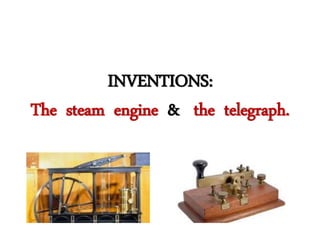
The steam engine and the telegraph
- 1. INVENTIONS: The steam engine & the telegraph.
- 3. How did people travel in the past?
- 4. - They travelled in carriages or stagecoaches. It used horse – power. - People travelled on foot too. There were no roads!!
- 5. And… how do we travel nowadays?
- 6. - Today, we travel by car, plane, train… TECHNOLOGY HAS CHANGED TRAVEL. WE HAVE FOUND NEW WAYS TO MAKE TRAVEL EASIER!!!
- 7. And… do you know how objects were made in the past?
- 8. - They were made by hand. It took them a long time.
- 9. First, most factories and mills were powered by Water was a good source of power, but factories had to be located near a river and rivers could dry up during a drought or freeze during the winter. A factory A mill Wind didn’t always blow.
- 10. WHAT DID WE DO? -We invented the STEAM ENGINE. WHEN? -About 250 years ago. The steam engine used the steam from boiling water.
- 11. HOW DOES THE STEAM ENGINE WORK? chimney fire coal water piston flywheel · Steam engines use hot steam from boiling water to drive a piston back and forth. The movement of the piston is used to power a machine or turn a wheel . To create the steam, most steam engines heated the water by burning coal. boiler steam
- 12. Let’s watch a video to understand how it works more clearly! https://www.youtube.com/watch?v=73txXT21aZU
- 13. The STEAM ENGINE was one of the most important inventions of the INDUSTRIAL REVOLUTION. Steam engines were used in all sorts of applications including factories, mines, locomotives and steamboats. WHAT DID IT MEAN? - It meant that: 1st) Objects could be made in factories. 2nd) People and products could travel much more quickly. It was a TRANSPORT REVOLUTION.
- 14. WHY? - Because people built railways to connect cities. could travel faster. Now, factories are located anywhere.
- 15. THE TELEGRAPH
- 16. How did people communicate in the past (before we had telephones, computers…)?
- 17. - Smoke signals. - Flag signals. - Blowing horns. - A messenger. - Visiting people. - …
- 18. ACTIVITY • Now, I need 7 volunteers to play a game! We’re going to play “The broken telephone”!! I’ll tell one person a sentence, which he/she must memorize and pass on to the next person, by whispering. The next person will pass the sentence to the next and so on until it finally gets to the last person in the group. That last person will then have to say what the sentence is.
- 19. · The sentence: “It’s Natural Sciences time and we’re having a good time. We’re talking about the steam engine, the transport revolution, how people communicated in the past…”
- 20. Are they the same sentence? - No, they aren’t! It’s a mad distortion of the original! COMMUNICATION IN THE DISTANCE IS IMPORTANT. We invented the TELEGRAPH.
- 21. Before we had telephones and computers, people sent messages using a TELEGRAPH machine. It started a COMMUNICATION REVOLUTION. WHEN? - About 170 years ago. HOW DID PEOPLE USE IT? - Using something called MORSE CODE.
- 22. They used long and short sounds written as dots ( ) and dashes ( ) for different letters and numbers.
- 23. ACTIVITY • In groups, you have to send your own secret messages! You have to write your words in Morse Code. Leave a space between letters and words. Then, your classmates have to write the decoded words you have sent.
- 24. - 2 students: to prove this invention. ACTIVITY WHAT HAPPENS? Speaking into the plastic cup creates sound waves which are converted into vibrations at the bottom of the cup. The vibrations travel along the string and are converted back into sound waves at the other end so your friend can hear what you said.
- 25. Sound travels through the air, but it travels even better through solids, allowing you to hear sounds that might be too far away when traveling through the air. WHAT DID WE DO? - We invented the TELEPHONE. WHEN? - About 140 years ago. NOW… - we use COMPUTERS AND SMARTPHONES.
- 26. ACTIVITY We’re going to divide the class into 3 groups: industry, transport and communication. The relevant group stands up! 1. Steam engine. 2. Tablet. 3. Factories. 4. Telegraph. 5. Computer. 6. Railways. 7. Telephone. 8. Ships.
